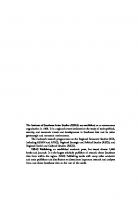Getting a Dial Tone: Telecommunications Liberalisation in Malaysia and the Philippines 9789812305664
"Ninety-nine percent of Filipinos are waiting for a telephone and the other one percent for a dial tone…” - Lee Kua
131 78 3MB
English Pages 434 Year 2007
Contents
List of Tables
List of Figures
List of Appendices
List of Abbreviations
Acknowledgements
1 Rent-Seeking, Market Reforms, and States
2 Reviewing the Literature: Theories and Puzzles
3 Historical Overview of the State and Business in Malaysia and the Philippines
4 The Telecommunications Sector in Malaysia and the Philippines Before Reform
5 Reforming the Malaysian Telecommunications Sector
6 The Liberalisation of Telecommunications in Malaysia
7 Regulatory Reforms in Malaysia
8 Reforming the Telecommunications Sector of the Philippines
9 The New Players and the Service Area Scheme
10 Regulatory Reforms in the Philippines
11 Conclusions
Appendices
Bibliography
Index
About the Author
Recommend Papers

- Author / Uploaded
- John Monfries
File loading please wait...
Citation preview
Getting a Dial Tone
00 Salazar pi-xxii.indd 1
9/6/07 4:43:05 PM
The Institute of Southeast Asian Studies (ISEAS) was established as an autonomous organization in 1968. It is a regional centre dedicated to the study of socio-political, security, and economic trends and developments in Southeast Asia and its wider geostrategic and economic environment. The Institute’s research programmes are the Regional Economic Studies (RES, including ASEAN and APEC), Regional Strategic and Political Studies (RSPS), and Regional Social and Cultural Studies (RSCS). ISEAS Publishing, an established academic press, has issued almost 2,000 books and journals. It is the largest scholarly publisher of research about Southeast Asia from within the region. ISEAS Publishing works with many other academic and trade publishers and distributors to disseminate important research and analyses from and about Southeast Asia to the rest of the world.
00 Salazar pi-xxii.indd 2
9/6/07 4:43:05 PM
Getting a Dial Tone Telecommunications Liberalisation in Malaysia and the Philippines
LORRAINE CARLOS SALAZAR
INSTITUTE OF SOUTHEAST ASIAN STUDIES Singapore
00 Salazar pi-xxii.indd 3
9/6/07 4:43:06 PM
First published in Singapore in 2007 by Institute of Southeast Asian Studies 30 Heng Mui Keng Terrace Pasir Panjang Singapore 119614 E-mail: [email protected] Website: http://bookshop.iseas.edu.sg All rights reserved. No part of this publication may be reproduced, stored in a retrieval system, or transmitted in any form or by any means, electronic, mechanical, photocopying, recording or otherwise, without the prior permission of the Institute of Southeast Asian Studies. © 2007 Institute of Southeast Asian Studies, Singapore The responsibility for facts and opinions in this publication rests exclusively with the author and her interpretation does not necessarily reflect the views or the policy of the Institute or its supporters. ISEAS Library Cataloguing-in-Publication Data Salazar, Lorraine Carlos. Getting a dial tone : telecommunications liberalisation in Malaysia and the Philippines 1. Telecommunication—Government policy—Malaysia. 2. Telecommunication—Government policy—Philippines. 3. Privatisation—Malaysia. 4. Deregulation—Philippines. I. Title. HE8390.6 Z5S26 2007 ISBN 978-981-230-381-3 (soft cover) ISBN 978-981-230-382-0 (hard cover) ISBN 978-981-230-566-4 (PDF) Cover Photo: Condo Diwa, an ex-Moro National Liberation Front combatant turned seaweed farmer, uses his mobile phone to obtain and compare market prices for seaweeds. Wider coverage and more affordable services are some of the benefits of telecommunication liberalisation. Photo courtesy of USAID’s Growth with Equity in Mindanao (GEM) Project. Typeset by International Typesetters Pte Ltd Printed in Singapore by Mainland Press Pte Ltd
00 Salazar pi-xxii.indd 4
9/6/07 4:43:06 PM
For Nanay and Tatay
00 Salazar pi-xxii.indd 5
9/6/07 4:43:06 PM
00 Salazar pi-xxii.indd 6
9/6/07 4:43:06 PM
Contents
Map of Malaysia and the Philippines List of Tables List of Figures List of Appendices List of Abbreviations Acknowledgements
viii ix xi xii xiv xix
1 Rent-Seeking, Market Reforms, and States 2 Reviewing the Literature: Theories and Puzzles 3 Historical Overview of the State and Business in Malaysia and the Philippines 4 The Telecommunications Sector in Malaysia and the Philippines Before Reform 5 Reforming the Malaysian Telecommunications Sector 6 The Liberalisation of Telecommunications in Malaysia 7 Regulatory Reforms in Malaysia 8 Reforming the Telecommunications Sector of the Philippines 9 The New Players and the Service Area Scheme 10 Regulatory Reforms in the Philippines 11 Conclusions Appendices Bibliography Index About the Author
1 18 48
00 Salazar pi-xxii.indd 7
86 133 160 198 225 258 298 325 339 375 396 412
9/6/07 4:43:07 PM
L~ THAILAND
-o·::.•D Paracellslands
A\
J
D
\.a·': 1 j
•
PH I
S ., E
(-··-.J'v.f"·.(
INES
T
• CAMBODIA : N
-· j
-~·
..lA
M
Spratly .• Islands .;.
.. .
South China
Sea
--·. .......... . \ 0
"'- ........., ,.':':· .....
L•'
t
Bandar Sari
A y s
)
![European Telecommunications Liberalisation [1 ed.]
0415187818, 9780415187817, 9780203983010](https://ebin.pub/img/200x200/european-telecommunications-liberalisation-1nbsped-0415187818-9780415187817-9780203983010.jpg)







![The Liberalisation of the Telecommunications Sector in Sub-Saharan Africa and Fostering Competition in Telecommunications Services Markets: An Analysis ... on Innovation and Competition Book 6) [1st ed. 2018]
9783662553183, 9783863040154, 366255318X](https://ebin.pub/img/200x200/the-liberalisation-of-the-telecommunications-sector-in-sub-saharan-africa-and-fostering-competition-in-telecommunications-services-markets-an-analysis-on-innovation-and-competition-book-6-1st-ed-2018-9783662553183-9783863040154-366255318x.jpg)
